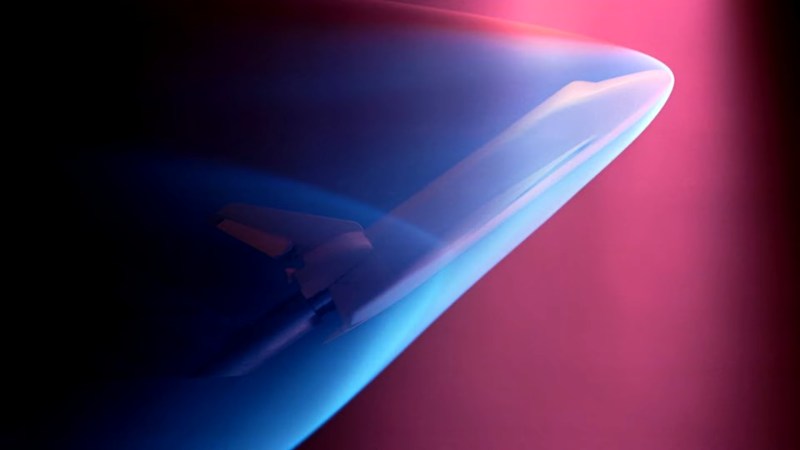Hypersonic speeds are defined by those exceeding Mach 5, and lately there’s been a lot of buzz about unmanned hypersonic vehicles making test flights. Vehicles returning from orbital flight also travel at hypersonic speeds as they do their best to transition back to the terrestrial realm. Before anything leaves ground though, these machines are tested in wind tunnels. [Scott Manley]’s video “How Hypersonic Wind Tunnels Recreate Mach 20” (embedded below) does a wonderful job of explaining the engineering behind wind tunnels for testing hypersonic vehicles.
While the earliest wind tunnels such as that used by the Wright Brothers were powered by simple fans, it is not possible for any propeller to surpass subsonic speeds. This is evidenced by there not being any propeller driven aircraft that can exceed Mach 1. Since an aircraft can’t reach those speeds with a propeller, it follows that a wind tunnel cannot be driven by propellers, fans, or any such device, and exceed Mach 1 wind speed, either. So it begs the question: Just how do they do it?
You might think that the answer lays in Bernoulli’s law – but it does not. You might think it involves compressing the air into smaller and smaller tubes and pipes. It doesn’t. As [Scott Manley] so expertly explains in the video below the break, it has quite a lot in common with actual rocket science.
You may be interested to know that we’ve covered some DIY wind tunnel builds as well as a small desktop wind tunnel in the past. While not hypersonic, they’re exactly what you’d want to have if you’re an aerospace hacker of any kind.
Thanks [Zane Atkins] for the tip!
















there is a Scientific American amateur scientist article on building a super sonic wind “tunnel”
the test chamber is about 50mm, the wind velocity was basically a 44 gallon drum pumped down to near vacuum with a ball valve to let the air back in
I really love how Scott Manley breaks things down and makes even the most complicated things easy to understand. The best part is my kids will actually pay attention to him because he is funny and they like his accent. Fly safe! o7
Note this doesn’t beg the question, it just asks it.
Begging the question is a logical fallacy, where your argument to support a proposition assumes that the proposition is correct, aka arguing in a circle.
And, yeah, this is like arguing that literally should not be used figuratively and that most people misuse decimate, but it’s worth pointing out that there is a logical fallacy of making self-referential arguments, because this is the sort of argumentation that seems persuasive when you first hear it.
I have to admit that that last sentence was remarkably satisfying to read, in spite of (or perhaps precisely because of) how dizzy I felt when I finally reached the period. :D
@Ryan Flowers said: “…it is not possible for any propeller to surpass subsonic speeds. This is evidenced by there not being any propeller driven aircraft that can exceed Mach 1.”
Ummm…
1. Supersonic Propeller (McDonnell XF-88B)
http://www.aerospaceweb.org/question/aerodynamics/q0031b.shtml
NACA research during the mid-1940s did show that supersonic prop-driven aircraft were feasible, but the key was developing propellers that could operate at or near the speed of sound. NACA began a high-speed propeller development program that culminated in the supersonic propeller, but this kind of prop is substantially different from those used on the fastest propeller-driven aircraft of the day, like the P-51 Mustang. Beyond speeds of Mach 0.9, the prop blades must become significantly shorter and thinner and the blade angle (the angle of attack of the blade) must be decreased compared to blades used on previous aircraft. An example is the test propeller mounted to the nose of an XF-88 research aircraft.
2. Supersonic Propeller on a Supersonic Plane (sort-of, McDonnell XF-88B again)
https://en.wikipedia.org/wiki/Fastest_propeller-driven_aircraft#Turboprops
McDonnell XF-88B, which was made by installing an Allison T38 turboshaft engine in the nose of a pure jet-powered XF-88 Voodoo. This unusual aircraft was intended to explore the use of high-speed propellers and achieved supersonic speeds. This aircraft exceeded the speed of sound (Mach 1.2) on the propeller alone, but only in a dive, and it wasn’t in two directions, which is necessary for the FAI’s record book.
3. Another Supersonic Propeller (Republic XF-84H Thunderscreech)
https://en.wikipedia.org/wiki/Republic_XF-84H_Thunderscreech
Supersonic propeller: Thrust was adjusted by changing the blade pitch of the 12 ft (3.7 m) diameter Aeroproducts propeller, consisting of three steel, square-tipped blades turning at a constant speed, with the tips traveling at approximately Mach 1.18 (1,446 km/h).
Subsonic XF-84H plane: Maximum speed 520 mph (837 km/h, 450 kn).